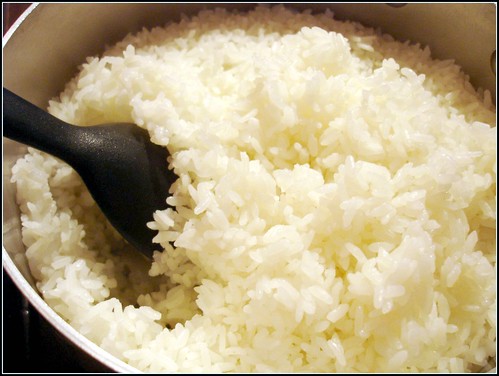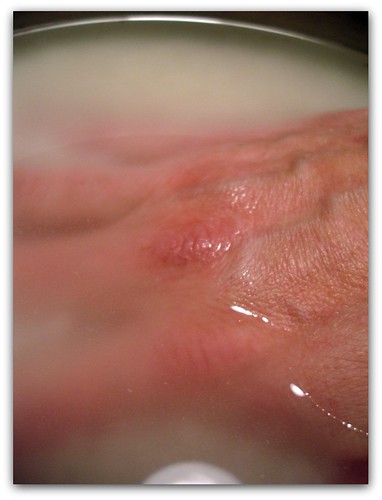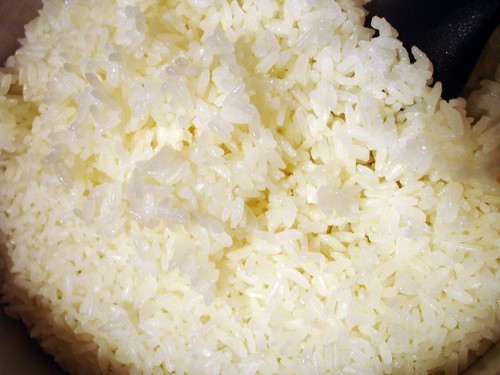GF: Making perfect sticky rice: Fluff and Go!
(A little side note: I finally finished linking the recipes to a single recipe page. Please click on the link above titled “Recipes” to find a list of all of the Gluten-Free recipes on this site.)
And back to the regularly scheduled post….
This week marks Chinese New Year. It’s one of my favorite holidays ever. I think I’ve always held a special place in my heart for times of the year that celebrate lunar events, but now that I am member of a Chinese family, the real traditions have begun to seep into my bones. It is really a beautiful holiday and refreshing at that.
Thursday, February 7th, ushers in the Year of the Rat. Now, I know you are wondering how a gluten-free food blog even dares mention the word “Rat” but it’s not like that at all, promise. Rats, actually, are a highly honored and respected Zodiac animal for their strong instincts and courage. Much like us gluten-free lifestylers, huh? We have good instincts about food (at least we have been learning to be more attentive to them, huh?) and courageously venture into the lands of the little-known grains to make up for wheat, etc.
Ok, I’m swinging in the wind – but you have to admit, some of that is true!
Chinese New Year is a family holiday. It is the one time of year that the family does everything possible to be together to celebrate dinner, give lucky money to younger, unmarried people/kids, share in laughter and love and revel in the security of the group.
Before New Year’s Day (Thursday, this year), all debts are settled, the house is cleaned from top to bottom thoroughly (I swear it’s the only time of the year that I don’t mind dusting!), and clean linens etc are readied. On New Year’s Day none of these cleaning tasks should be performed because you would be sweeping out the good luck that the New Year had brought you!
Typically, when we have been able to be with family on this holiday, we all gather (uncles, cousins, etc) at the home of my in-laws for a fabulous meal (8 or more courses) served family style and several hours of laughter and talking.
When I got married, my mother-in-law filled me in on the traditions that take place before the big event or family dinner. She told me that when her children were little, she would often wake them up in the middle of the night on New Year’s Eve to make sure they ate some fruit, vegetables and rice (but no meat!). This would bring the kids good luck and health for the year. Eating meat was a sign of disrespect – taken from their vegetarian/Buddhist background as a way to honor all life on this day/moment. In fact, she told me that while she would let the kids eat meat on New Year’s Day if they wanted (it is always served at the dinner anyway), she and my father-in-law would not eat meat until they were together for the family dinner.
While my husband and I haven’t always stayed up late on New Year’s Eve to eat veggies and fruit, we have always done so first thing in the morning. And we have vowed to do so when we have children of our own. In the meantime, we continue a few other family traditions for the New Year.
We hang signs around the house (red paper with gold lettering) that invite good luck, fortune, health and happiness into our home. And we burn incense to clear the air from negative thoughts or moods and give us the chance to start over. We plan a meal to celebrate family and friends.
When we have had the time/money, we have hosted a Chinese New Year party for family/friends. This has always been great fun. For the party, a minimum of 8 dishes must be prepared and served. These dishes always include one dish (at least) made with chicken, one with beef, one with seafood/fish, and one with pork. The other four dishes as usually lighter, but may also contain meat. We have often made a mochi sweet rice cake (steamed or baked). And there is always a huge pile/plate of oranges. (Although the oranges do not count as one of the 8 dishes.)
Lucky money is typically handed out to kids or unmarried young adults from older relatives or close family friends. The lucky money envelopes are small and red. They contain two bills of some denomination (maybe 2 one dollar bills, or 2 five dollar bills, etc). One bill is not the best of luck, but is certainly better than nothing! The monetary value is not what is important. The lucky money envelope may have $2.00 total, it doesn’t matter. It’s about offering luck, health, and prosperity. It’s a symbol of well-wishes and good fortune at this time of year. (Other times when lucky money is offered this idea remains, but the monetary value differs – especially for large events like weddings. Consider a gift of lucky money at these events to be similar to what you would give as gift – only you give cash instead.)
There are a few great links I want to share with you so you can see what your New Year has in store for you. There are many things you may be interested in trying out for yourself for the holiday or even for the New Year. (Like the one year my mother-in-law told me that my Chinese horoscope suggested I only wear red underwear FOR THE YEAR. LOL) Sometimes the fun of a new Holiday is just what you need for Chinese New Year.
Welcome in your new year with joy in your heart, a clean house, and a hopeful glance into your future. THAT will set your fortunes in motion more than you know.
In the meantime, this week as we prepare our Chinese dishes (we’ve already made a few that we can share recipes for), I thought I would start with a quick post on how to make the perfect sticky rice. Sticky short-grain rice is the basis for many a good Asian dish. Making it fluffy is key, though. Dense, wet rice is not a tasty accompaniment. I hope these tips will be of help you.
One more thing, I’ve never measured ingredients for making rice since learning these techniques from my in-laws and the quality of the finished rice is consistently great. Trust your instincts and you’ll get it perfect.
Here’s an outline of what we do:
Making Perfect Sticky Rice
- Into a saucepan for which you have a lid (lol), scoop about 5-6 oz of rice for each person you plan on serving. (This will make plenty of rice – enough for leftovers for lunch the next day. If you don’t want that much rice, make the serving about half or two-thirds of this.) I use a recycled, cleaned empty yogurt cup or a small plastic cup (that holds about 6 ounces total – one one yogurt serving). I just leave the clean cup in our bag of rice for exactly this purpose.
- With running water, as cold as you can stand it – don’t use HOT water for this – fill the saucepan with water. Swish and swirl the water around with the rice grains with your hand to loosen the excess starches and wash the rice. Rinse and repeat. Repeat this step as often as it takes for the water to run practically clear (three or four times, depending upon the brand of rice you buy).
- Now, fill the pan again with water, but this time measure up to the “Mt. Fuji Method” for cooking. This means that you fill the water in the saucepan up over the top of the rice to what looks like about 1/3 of an inch. Then you put your hand flat on top of the rice. The water level should some to the knuckle of your large finger at the base of your hand. (See the picture below). Add or remove water until you have reached this point. (You do somewhat squish your hand in to the rice to measure this way. You want to make sure that the palm of your hand is flat on the rice and pushing down a bit.)
- Cover the rice and place over a high-flame on the stove until it begins to boil rapidly. Decrease the flame to the lowest simmer possible. Do not remove the lid. Continue simmering for 15-18 minutes (this may vary depending upon your heat level and the type of rice, etc). Lift the lid to check the rice. You will be able to see that the rice is done when there are a few large “holes” in the top of the rice. (The holes are made by the evaporating water/steam.). Do not stir the rice to check doneness. If you cannot tell, pluck a couple grains of rice from different places along the top and taste-test.
- Let the rice sit a bit off the heat with the lid on to finish teaming. Fluff with a large spoon by sliding the spoon along the side and flipping up the rice from the bottom. The rice should fluff easily. If it is “wet”, then it has not steamed long enough. Return it to the stove to cook longer.
Did you burn your rice to the pan? No worries!
- To remove burnt rice, first remove all the rice you can save – but DON’T scrap the rice off the pan. Instead, return the practically empty pan to the stove and turn the heat/flame to high. Cook the rice until the sides are browning and sizzling. (Then wait 15 seconds longer…LOL – be sure you aren’t antsy!) Once the rice on the side of the pan has browned on the sides (not the top), quickly pull the pan off the heat and add some cold water. Return to the stove (medium flame now) and scrap the rice off the pan/sides. It should come off in large chunks and much more easily now. (This rice “soup” is actually a much loved food item to eat amongst my Chinese family. I think they all are quite happy if I’ve burned the rice bottom a bit. LOL. It is a normal thing to have happen and the rice/water at the bottom once you’ve gotten it all scrapped off, does have a unique toasted flavor to it. Try it. You might like it too. )
Happy Rice Making!
I’ll be back later this weekend/early this week with your Chinese Horoscope and New Year links. 🙂
-Kate
PS. What kind of Chinese food recipes are you craving? Drop me a note – let’s see if I have a recipe for it. (Or I’ll hit up my love or in-laws to see if they can help out. LOL)


